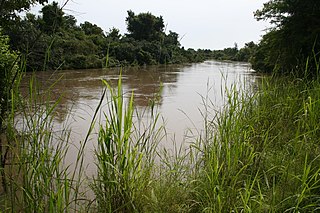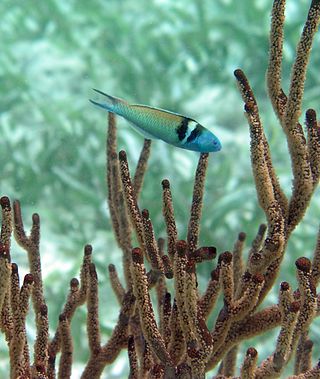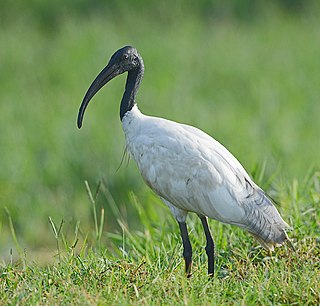This is an index of conservation topics. It is an alphabetical index of articles relating to conservation biology and conservation of the natural environment.
A biodiversity hotspot is a biogeographic region with significant levels of biodiversity that is threatened by human habitation. Norman Myers wrote about the concept in two articles in The Environmentalist in 1988 and 1990, after which the concept was revised following thorough analysis by Myers and others into "Hotspots: Earth's Biologically Richest and Most Endangered Terrestrial Ecoregions" and a paper published in the journal Nature, both in 2000.

A Ramsar site is a wetland site designated to be of international importance under the Ramsar Convention, also known as "The Convention on Wetlands", an international environmental treaty signed on 2 February 1971 in Ramsar, Iran, under the auspices of UNESCO. It came into force on 21 December 1975, when it was ratified by a sufficient number of nations. It provides for national action and international cooperation regarding the conservation of wetlands, and wise sustainable use of their resources. Ramsar treaty participants meet regularly to identify and agree to protect "Wetlands of International Importance", especially those providing waterfowl habitat.

The W National Park or W Regional Park is a major national park in West Africa around a meander in the Niger River shaped like the letter W. The park includes areas of the three countries Niger, Benin and Burkina Faso, and is governed by the three governments. Until 2008, the implementation of a regional management was supported by the EU-funded project ECOPAS. The three national parks operate under the name W Transborder Park. The section of W National Park lying in Benin, measuring over 8,000 km2 (3,100 sq mi), came under the full management of African Parks in June 2020. In Benin, W National Park is contiguous with Pendjari National Park which is also under the management of African Parks.
An Endemic Bird Area (EBA) is an area of land identified by BirdLife International as being important for habitat-based bird conservation because it contains the habitats of restricted-range bird species, which are thereby endemic to them. An EBA is formed where the distributions of two or more such restricted-range species overlap. Using this guideline, 218 EBAs were identified when Birdlife International established its Biodiversity project in 1987. A secondary EBA comprises the range of only one restricted-range species, or an area which is only the partial breeding range of a range-restricted species.

A bird reserve is a wildlife refuge designed to protect bird species. Like other wildlife refuges, the main goal of a reserve is to prevent species from becoming endangered or extinct. Typically, bird species in a reserve are protected from hunting and habitat destruction. Because of the protection they provide from such threats, bird reserves also serve as excellent locations for bird watching. Normally, wildlife refuges are under the care of non-profit organizations and governmental institutions.

Burkina Faso is largely wild bush country with a mixture of grass and small trees in varying proportions. The savanna region is mainly grassland in the rainy season and semi desert during the harmattan period. Fauna, one of the most diverse in West Africa, includes the elephant, hippopotamus, buffalo, monkey, lions, crocodile, giraffe, various types of antelope, and a vast variety of bird and insect life. The country has 147 mammal species, 330 aquatic species including 121 species of fish and 2067 different plant species. Of the plant species, the dominant endemic species are shea tree and the baobab, the former plant species has immense economic value to the country.

Since declaring independence in 1981, Belize has enacted many environmental protection laws aimed at the preservation of the country's natural and cultural heritage, as well as its wealth of natural resources. These acts have established a number of different types of protected areas, with each category having its own set of regulations dictating public access, resource extraction, land use and ownership.

The Gallocanta Lake is an endorheic lake in Aragon, Spain. It is located between the Teruel and Zaragoza provinces. The lake is located just to the south of Gallocanta village, between the Aragonese comarcas of Campo de Daroca and Comarca del Jiloca. This lake is situated on a high continental plain at an altitude of almost 1,000 m.
Lake Warden is a salt lake in the Goldfields-Esperance region of Western Australia. It and its associated wetlands are protected in a nature reserve; they were recognised as being of international importance under the Ramsar Convention through designation of the Lake Warden System on 7 June 1990 as Ramsar Site 485. The lake is also a DIWA-listed wetland.

Mangrove ecosystems represent natural capital capable of producing a wide range of goods and services for coastal environments and communities and society as a whole. Some of these outputs, such as timber, are freely exchanged in formal markets. Value is determined in these markets through exchange and quantified in terms of price. Mangroves are important for aquatic life and home for many species of fish.

The World Database on Protected Areas (WDPA) is the largest assembly of data on the world's terrestrial and marine protected areas, containing more than 260,000 protected areas as of August 2020, with records covering 245 countries and territories throughout the world. The WDPA is a joint venture between the United Nations Environment Programme World Conservation Monitoring Centre and the International Union for Conservation of Nature World Commission on Protected Areas.

The Coongie Lakes is a freshwater wetland system located in the Far North region of South Australia. The 21,790-square-kilometre (8,410 sq mi) lakes system is located approximately 1,046 kilometres north of the Adelaide city centre. The wetlands includes lakes, channels, billabongs, shallow floodplains, deltas, and interdune swamps. It lies on the floodplain of Cooper Creek, an ephemeral river flowing through a desert landscape in the Lake Eyre Basin which rarely, after occasional large floods, empties into Lake Eyre. The wetland system has been recognised both as being of international importance by designation under the Ramsar Convention with a listing on 15 June 1987 and being nationally important within Australia with a listing in A Directory of Important Wetlands in Australia (DIWA). Its extent includes the regional town of Innamincka, the Malkumba-Coongie Lakes National Park, the Innamincka Regional Reserve, the Strzelecki Regional Reserve and the Coongie Lakes Important Bird Area.

Key Biodiversity Areas (KBA) are geographical regions that have been determined to be of international importance in terms of biodiversity conservation, using globally standardized criteria published by the IUCN as part of a collaboration between scientists, conservation groups, and government bodies across the world. The purpose of Key Biodiversity Areas is to identify regions that are in need of protection by governments or other agencies. KBAs extend the Important Bird Area (IBA) concept to other taxonomic groups and are now being identified in many parts of the world. Examples of types of KBAs include Important Plant Areas (IPAs), Ecologically and Biologically Significant Areas (EBSAs) in the High Seas, Alliance for Zero Extinction (AZE) sites, Prime Butterfly Areas, Important Mammal Areas and Important Sites for Freshwater Biodiversity, with prototype criteria developed for freshwater molluscs and fish and for marine systems. The determination of KBAs often brings sites onto the conservation agenda that hadn't previously been identified as needing protection due to the nature of the two non-exclusive criteria used to determine them; vulnerability; and irreplaceability.

The Murray-Sunset, Hattah and Annuello Important Bird Area comprises 7004 km2 of mallee habitat in the Mallee region of north-western Victoria, Australia.
The Sakumo Ramsar Site also known as the Sakumo Lagoon is a wetland of international importance. It covers an area of 1,400 hectares and is situated along the coastal road between Accra and Tema in the Greater Accra Region of Ghana. It is about 3 km (1.9 mi) west of Tema. Activities ongoing within the site include farming, fishing, recreation, urban and industrial development.

Basai wetland, located in Basai village in Gurgaon tehsil in Gurgaon district in Haryana, India, is a flora and fauna rich water body. It is recognised as one of India's Important Bird and Biodiversity Areas and is of global conservation significance as it supports populations of several endangered, vulnerable, and threatened bird species. Basai wetlandis recognised globally as an Important Bird Area (IBA) by the BirdLife International housing 20,000 birds of over 280 species including migratory birds and endangered birds, has not yet been declared a protected wetland by the Government of Haryana.

The Karaivetti Bird Sanctuary is a 4.537-square-kilometre (1.752 sq mi) protected area and Ramsar site, located in the Ariyalur District of the state of Tamil Nadu, India. The sanctuary is about 25 kilometres (16 mi) from Thanjavur. This freshwater lake is fed by Pullambadi, Kattalal canal and attracts thousands of birds every year. This lake was declared as a sanctuary in 1999 by the Government of Tamil Nadu and in 2024, it became a Ramsar site. About 200 birds are species recorded from this sanctuary. Karaivetti Bird Sanctuary is one of the Important Bird Areas (IBA's) of Tamil Nadu.

Nagi Bird Sanctuary is located in Jhajha Jamui district of south Bihar, near the Jharkhand border. It was declared a bird sanctuary on 25 February 1984 as per Section 18 of the Wildlife (Protection) Act, 1972. The final notification under Section 26A of the act was issued on 4 September 2009. Thousands of migrating birds congregate in the reservoir during the winter season, especially from November to February. The area of the sanctuary is 2.1 square kilometres. It is home to over 133 bird species. There are also a variety of dragonflies, damselflies and butterflies which are yet to be studied and documented. In 2004, Nagi Dam Bird Sanctuary was declared an Important Bird Area (IBA) by BirdLife International. The area overlapping with the IBA is 791 ha.



















